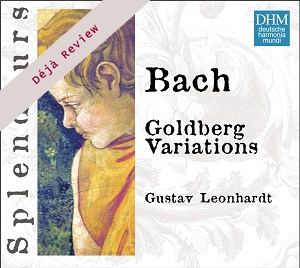
Déjà Review: this review was first published in September 2004 and the recording is still available.
Johann Sebastian Bach (1685-1750)
Goldberg Variations BWV988
Gustav Leonhardt (harpsichord)
rec. 1978, Haarlem, The Netherlands
Deutsche Harmonia Mundi 82876601462 [47]
The greatest set of variations ever composed is not something that the CD listener should have in only a single performance. The Goldberg Variations is one of those works that stands not only repeated and concentrated listening, but can tolerate repeated recording – something that most works do not justify. There has, of course, long been discussion over whether this consummate work of pure keyboard music is best played on the harpsichord or the piano. While it is an interesting musicological discussion point, bringing with it an encapsulation of all the arguments about supposed authenticity and “what the composer would have heard”, all of which can be countered with the famous “Bach’s plumbing” argument (if he had had the modern version he would have used it and enjoyed it). However, the argument is, at the same time, somewhat moot as the music itself is of such incomprehensible greatness that it withstands performance of almost any kind. Thus, one repeats the point that there is sense in owning multiple versions of this work. There is much to be said for Joanna McGregor’s thoughtful piano interpretation, and many would not be without versions by other pianists, including Glenn Gould. When considering the performances on the harpsichord, there is a similar range of options available. But however many of these the listener might want to hear there is an almost obligatory requirement to compare harpsichordists, and even pianists, when playing Bach, to Gustav Leonhardt.
Leonhardt and Bach is one of those pairings that defies description, so intimately are the two connected. The 1978 Goldberg recording on Deutsche Harmonia Mundi is certainly less flash than many later performances and Leonhardt avoids drawing too much attention to the virtuosity inherent in Bach’s keyboard writing. Tempi are on the broad side. Indeed, the first variation, with its leaping left hand, is quite sedate. This is not a performance that will set the listener on fire. Instead, Leonhardt is able to find the depths of the music without recourse to highly polished surface detail. The reason for the sedate tempo at the beginning is less to do with virtuosity (being employed or ignored) and more to do with architectural integrity. It is this indefinable sense of the progression of architectural structure that sets Leonhardt apart from the rest. One is aware from the opening chord of the Aria that Leonhardt can already see the opening chord of its reprise thirty variations later and knows the position and proportion of all the intervening variations from that opening chord. This gives the whole performance a tremendous sense of authority and dignity –features characteristic of Leonhardt’s playing.
Having mentioned above that depth is exploited in place of polish on the surface detail, this is not to imply that the surface detail is in any way flawed. While Leonhardt does not emphasise the virtuosity inherent in the writing, he has such command of his technical facility that there is plenty of drama when he wants it. Variation four, with manuals coupled, gives a strongly rhythmic, masculine effect, contrasted immediately with the delicate flowing movement of variation five in constant semiquavers. Once again the tempo is not especially high, but the clarity of the detail is remarkable, as is the slight variations in articulation of the figures. This keeps the music moving just as much as increased speed, but at the same time provides a level of surface detail that cannot be achieved by tempo alone. In this one must appreciate the distinction between surface detail and surface polish. This detail is again observable in the short fughetta of variation 10, a sure display of Leonhardt’s mastery of contrapuntal performance. When the need for virtuoso display really is there, in the Ouverture at variation 16, Leonhardt produces plenty of it. The bold French overture style of the opening juxtaposes big chords with ornamental runs. Every note of these runs is perfectly articulated – once again it is all about proportion, here on a minute scale, but producing a whole that is perfectly balanced, without ever appearing obvious. In variations 26and 29, outright speed is adopted, and is all the more impressive for being held in reserve until approaching the peroration.
Interestingly, in this recording Leonhardt was employing a reproduction harpsichord; a copy from 1975 by William Dowd, of an instrument of 1730 by the Parisian Blanchet. Perhaps the choice of a French style harpsichord could be viewed as odd, in comparison to a more ‘northern’ sounding Ruckers or Zell instrument. Clearly it is a large instrument – two manuals being almost essential in the Goldbergs – and the richness of sound is a constant pleasure. There is maybe a small regret that Leonhardt choose not to record on an original 18th century harpsichord, as he did frequently at other times, but the Dowd/Blanchet sound must be viewed simply as beautiful, and with plenty of appropriate gravity in the bass and powerfully balanced treble. There is certainly never an unattractive note. However much any listener might appreciate their personal favourite recording of the Goldberg Variations there should always be room on the shelf, and time made for careful, repeated listening, to the 20th century’s closest equivalent to hearing Bach himself playing. Gustav Leonhardt will always remain separate from mere ‘other’ harpsichordists. This really is sitting at the feet of the master.
Peter Wells
Help us financially by purchasing from



















